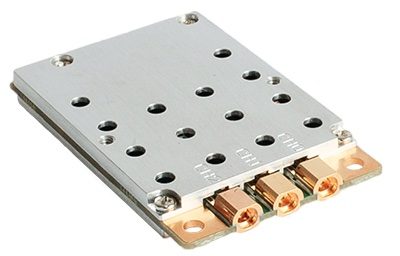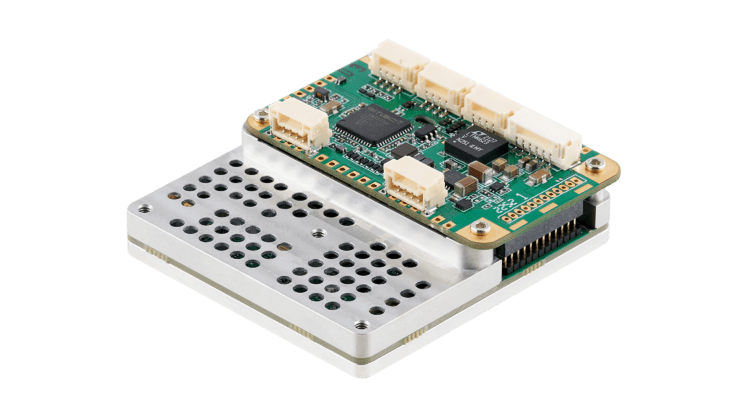Doodle Labs technology helps drones in combat evade jamming
By DRONELIFE Features Editor Jim Magill
The war in Ukraine, which has often been referred to as the world’s first drone war, has led to both sides in the conflict relying on fleets of small unmanned aerial vehicles to surveil enemy positions and drop bombs on enemy targets.
These small, inexpensive drones, frequently equipped with first-person viewpoint (FPV) technology, are increasingly being deployed effectively on the battlefield in lieu of manned aircraft or missiles, which are more expensive by several orders of magnitude. However, one problem with these unmanned aircraft is the ease with which the enemy can jam their radio signals, causing them to miss their targets or crash.
A Los Angeles-based start-up electronics company is working to develop solutions to this problem, offering anti-jamming technology for use by Ukraine and allied nations.
“I think it was initially unexpected, but there’s been just an incredible amount of innovation and creative uses of drones in the war,” Amol Prikh, co-CEO of Doodle Labs, said in an interview with DroneLife.
Prikh said that in recent months the company has been focused on supporting many drone manufacturers – including those based in Ukraine, as well as those of allied nations such as PDW, an American company, and UK-based Evolve Dynamics — by supplying them with anti-jamming technology for their various categories and sizes of drones used in combat.


He cited the company’s recent introduction of Sense, a new feature for Doodle Lab’s multi-band Mesh Rider Radios “that addresses the challenges of interference for long-range, mission-critical robotics and connected teams’ applications for a more resilient datalink,” according to a company statement.
“This anti-jamming capability of Sense has been something that’s really been useful and effective in those environments,” Prikh said. “Commercially available drones that don’t use any special type of data links like ours operate in Standard Wi-Fi frequency bands, which are known and very easily jammed.”




The same is true of FPV drones, some of which are built from scratch. Although they have proven to be surprising effective weapons on the battlefield and can be produced at a very low cost – making them expendable compared with much more expensive weapons – they contain a major flaw. They are typically flown using RC controllers, which transmit signals on a well-known bandwidth and are therefore very easy to jam.
“They represent an opportunity because instead of tens of thousands of dollars per drone, you’re now talking in terms of hundreds of dollars, and so they significantly represent a different type or class of drone,” Prikh said.
For these UAVs, Doodle Labs has developed a Sense solution that provides the drones with frequency agility, the ability of a radio system to quickly shift its operating frequency. This technology makes the FPV drones’ RC controllers more robust and capable of overcoming jamming attempts, while still remaining at a low price point.
DIU approved equipment
With headquarters in the U.S. and manufacturing facilities in Singapore, Doodle Labs has developed its radio technology under the sponsorship the U.S. Army’s Defense Innovation Unit, which focuses on accelerating the adoption of commercial technology for use by the U.S. Armed Forces at speed and scale. The company has worked in partnership with the U.S. Air Force, U.S. Navy and NASA to develop secure radio communication technologies.
“We are part of the Blue UAS system, and you’ll see that our radios are listed on the component list. We have several platforms that we’ve supported join the cleared list,” Prikh said.
Doodle Labs was launched in 2008 as a spin-off of smartBridges, a Wi-Fi technology company. The company’s early focus was on developing integrated wireless solutions for the emerging robotics industry. It built its core technology on top of smartBridges’ long-range wireless intellectual property with its proprietary frequency-shifting capabilities.
The company’s history of development in the commercial space allowed it to nimbly shift its focus into the defense sector, which puts a high priority on compliance with existing regulations, Prikh said.
“All of our unlicensed radios are FCC-certified. We follow those rules very strictly,” he said. “And we have really great, high-performing, low-cost options on the defense side in the federal frequency bands, while adding in that robustness.”
A key to Doodle Labs commercial success has been relaying on proven existing technology as the basis for developing its products rather than building everything from scratch. Prikh said this philosophy is a result of a strategic decision the company’s technical team made in its early days.
“We build off of Qualcomm chipsets. And so actually the way that we achieve our various frequency configurations is we start with a Wi Fi chipset at 2.4 GHz usually, and then we frequency shift it over to our other frequency bands,” he said.
Doodle Labs continues to work closely with Qualcomm, and shares feedback about its chips with the giant semiconductor and software company. This relationship helps Doodle Labs to make improvements to its product by building off of established commercial standards. A further benefit is that small-sized Doodle Labs is able to produce lower priced products by leveraging existing technology, while its competitors, including corporations, whose value can run into the billions-of-dollars level, invest millions on research and development to come up with new technology.
Dual-use company
Prikh said despite Doodle Labs’ recent focus on the defense sector, the company also maintains a robust commercial business side, developing drone communication technologies for surveying, mapping and warehouse operation, as well as for robotics companies, including for use in quadrupeds such as Boston Dynamics’ dog-like robot Spot.
“I would say we truly operate in the dual-use category,” he said. “There are advancements and unique use cases and high potential to scale on both sides.”
For example, he again cited the company’s Sense feature, which offers frequency agility to add anti-jamming capability on the battlefield.
“On the commercial side, it works just as well, but the interference is coming through passively from a lot of Wi-Fi devices or things like that in an urban environment,” he said.
Read more:

 Jim Magill is a Houston-based writer with almost a quarter-century of experience covering technical and economic developments in the oil and gas industry. After retiring in December 2019 as a senior editor with S&P Global Platts, Jim began writing about emerging technologies, such as artificial intelligence, robots and drones, and the ways in which they’re contributing to our society. In addition to DroneLife, Jim is a contributor to Forbes.com and his work has appeared in the Houston Chronicle, U.S. News & World Report, and Unmanned Systems, a publication of the Association for Unmanned Vehicle Systems International.
Jim Magill is a Houston-based writer with almost a quarter-century of experience covering technical and economic developments in the oil and gas industry. After retiring in December 2019 as a senior editor with S&P Global Platts, Jim began writing about emerging technologies, such as artificial intelligence, robots and drones, and the ways in which they’re contributing to our society. In addition to DroneLife, Jim is a contributor to Forbes.com and his work has appeared in the Houston Chronicle, U.S. News & World Report, and Unmanned Systems, a publication of the Association for Unmanned Vehicle Systems International.
Miriam McNabb is the Editor-in-Chief of DRONELIFE and CEO of JobForDrones, a professional drone services marketplace, and a fascinated observer of the emerging drone industry and the regulatory environment for drones. Miriam has penned over 3,000 articles focused on the commercial drone space and is an international speaker and recognized figure in the industry. Miriam has a degree from the University of Chicago and over 20 years of experience in high tech sales and marketing for new technologies.
For drone industry consulting or writing, Email Miriam.
TWITTER:@spaldingbarker
Subscribe to DroneLife here.




